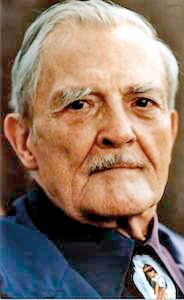Colourful life and colourful therapies
It was a hot summer day in Phoenix, Arizona, USA. In a corner house down a lane a group of therapists were waiting in the office room. All experienced therapists they had nevertheless come to learn from a man considered to be a wizard in therapy. The door opened and a man was pushed into the room on a wheelchair. Dressed in purple, he wore a bolo tie with purple cowrie shells. He was old but his eyes twinkled with the brightness of a much younger man.

Milton-Erickson
The man was Milton Erickson, the distinguished psychiatrist who is also recognized as the world’s foremost authority on clinical hypnosis and brief psychotherapy. Erickson passed away in 1980 at the age of 79.
His life was as colourful as his therapies and I thought we might be able to draw some useful lessons for our lives from this man. Milton Erickson was born to a farming family in Wisconsin and many of his stories were drawn from his experiences growing up on a farm. At the age of 17 he was stricken with polio and for months had to lie in bed paralysed. Later he recounted that during this period he was able to develop his remarkable powers of observation and his exquisite awareness of minute bodily movements in his patients. He said, “I also became extremely aware of physical movements, those adequate movements that are so revealing if one can notice them. So much of our communication is in our bodily movements, not in our speech.”
After his attack of polio he was told that he would never walk again but after hours of concentration he was able to gain a flicker of movement in the muscles of his leg. In a year he was walking on crutches. On entering the University of Wisconsin he was advised to exercise to further strengthen his legs. He decided to undertake a canoe trip down the Mississippi. In June of that summer he set off alone in a 17-foot canoe taking with him a sack of beans, another of rice, and a few cooking utensils. He had $ 2.32 in his pocket for further provisions, a meagre amount even in those days. He foraged for food along the way catching fish when he could and collecting the food thrown by steamers on the river.
By the end of summer he had travelled 1200 miles with hardly any money or food and without sufficient strength in his legs to carry his canoe over the dams blocking the river. Asked how he managed this he said, “I would shinny up one of the poles that are always around dams. Soon people would gather and look up curiously at me sitting up there reading a German book I brought with me in preparation for my medical studies. Finally someone would ask me what on earth I was doing on that pole. I would look from my book and say that I am waiting to get my canoe carried over the dam. This always meant volunteer service.”
When Erickson returned to university after his summer of canoeing, his chest measurement had increased by six inches, he could swim a mile and he could paddle upstream against a four-mile current. He could also carry his canoe over dams by himself.
Years later in 1952 he suffered a rare medical event when he was stricken with another strain of polio which affected his right arm and leg. But within a year he made a difficult mountain hike with the use of two canes. Such was the indomitable will of the man.
Erickson was both a psychiatrist and a psychologist, having simultaneously received his medical degree and his master’s degree in psychology. He was a Fellow of both the American Psychiatric Association and the American Psychopathological Association. He was the founding President of the American Society for Clinical Hypnosis as well as the founder editor of the society’s journal.
Though he used his talent in hypnosis to bring about change in people his main mode of working was through the use of stories. At times he would combine the two to make his patients more receptive to change. In telling stories Erickson was following an ancient tradition where stories have been used by our elders to transmit values and traditions. Like a bitter pill that is easier to swallow when coated in sugar, a lesson embedded in a story is more acceptable to a patient than direct moral preaching. Often Erickson’s stories were taken from his experience of growing up in a farming community in America.
 To illustrate how therapists should work with their patients he told the story of how once a horse without any identification marks wandered into their farm. Erickson offered to return the horse to its owner. He mounted the horse and let the horse decide which way he wanted it to go. He only intervened when the horse wandered into a field to graze. Finally the horse on its own turned into a farmyard and the farmer asked Erickson, “How did you know the horse came from this farm?” Erickson answered, “I didn’t but the horse knew, all I did was to keep it on the road.”
To illustrate how therapists should work with their patients he told the story of how once a horse without any identification marks wandered into their farm. Erickson offered to return the horse to its owner. He mounted the horse and let the horse decide which way he wanted it to go. He only intervened when the horse wandered into a field to graze. Finally the horse on its own turned into a farmyard and the farmer asked Erickson, “How did you know the horse came from this farm?” Erickson answered, “I didn’t but the horse knew, all I did was to keep it on the road.”
Another time his father, a big made farmer, was trying to pull a huge bull into his pen. The bull refused to budge. Young Erickson offered to do the job. His father rather sceptically invited him to go ahead and try. Erickson walked up and yanked the bull by his tail. The bull bolted forward right into his pen. Even as a young boy he was using a therapeutic strategy called paradoxical injunction where we prescribe the opposite of what we want the patient to do.
Over the next few months I will tell you more about Milton Erickson and some of his unusual therapies.


